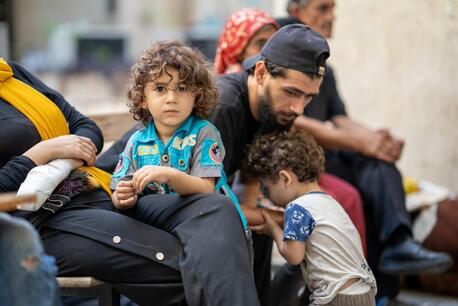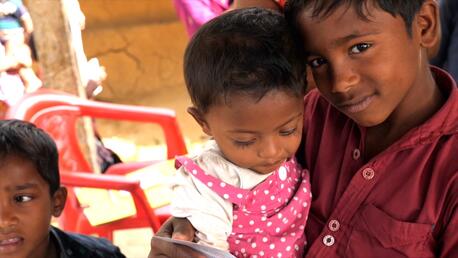
Connecting UNICEF's Past to Its Present — and Future
On December 11, 2021, UNICEF marked 75 years as an unstoppable force for change in the lives of children around the world. And through the decades, together with partners, major progress has been made — against disease, against poverty and other threats to children's health and well-being.
But now that progress is under threat due to the devastating impacts of the coronavirus pandemic. In fact, as UNICEF spells out in a recent report, COVID-19 is the biggest threat to children's rights and futures the organization has ever faced.
On its milestone anniversary, UNICEF is focusing on renewing its commitments to global action and mobilizing support for its many programs and interventions aimed at reversing the damage — and preventing what it fears could be a lost decade for the world's young people.
Helping children survive and thrive since 1946
UNICEF was established in 1946 to meet urgent needs of children who had suffered, and were still suffering, the brutal effects of World War II. And for three quarters of a century since, UNICEF has been helping children survive and thrive, protecting their rights and safeguarding their futures.
From the front lines of humanitarian crises, armed conflict and natural disasters, UNICEF has risen to every challenge while reimagining what is possible through committed partnerships and with a passion for innovation. Focusing on both short-term relief and long-term development and sustainability, UNICEF has helped build resilient health and welfare systems all across the globe — defeating diseases, providing essential services and developing healthier and safer environments for children and families everywhere.
Since COVID-19 hit, however, virtually every measure of progress for children have been rolled back. In Preventing a Lost Decade: Urgent action to reverse the devastating impact of COVID-19 on children and young people, UNICEF examines how the pandemic has pushed 100 million more children into poverty, widened inequalities and created a host of new challenges for child protection and mental well-being.
"While the number of children who are hungry, out of school, abused, living in poverty or forced into marriage is going up, the number of children with access to health care, vaccines, sufficient food and essential services is going down," UNICEF Executive Director Henrietta Fore said.
UNICEF maps out how it will keep working with partners to reimagine the future for every child in its 2022 plan for Humanitarian Action for Children (HAC) — drawing on 75 years of experience to get the job done.
To commemorate that history, we look back at how UNICEF's past work connects to its present — and future — mission, working nonstop to give children the support they need to look confidently ahead to better days.
Immunizing children against vaccine-preventable disease

Photo credits: left, © UNICEF/UNI41906; right, © UNICEF/UN0533183
Above left: In June 1961, a health worker in India vaccinates a girl against smallpox as part of a broader government-organized health campaign focusing on children in rural villages. UNICEF was a major supporter of the program, providing supplies and equipment to nearly 7,000 clinics. Smallpox was declared eradicated in 1980. The world is on track to do the same to polio; cases are down by over 99 percent since 1988 thanks to global immunization efforts supported by UNICEF and partners. Above right, a child in Liberia receives the oral polio vaccine in Bomi County, Liberia in March 2021. UNICEF is leveraging its expertise as the world’s largest vaccine buyer — last year procuring 1.9 billion doses of vaccines for children in 102 countries — to ensure delivery of COVID-19 vaccines in low- and lower-middle-income countries.
Providing emergency support

Photo credits: left, © UNICEF/UNI41895; right, © UNICEF/UN0253268/Moreno Gonzalez
Above left, an image from UNICEF's archives taken in the northwestern town of Castoria, Greece circa 1950. A boy holds a blanket supplied by UNICEF as part of an emergency relief effort for families who were displaced from their mountain villages further north during World War II. Above right: In October 2018, a UNICEF staffer hands a blanket to a displaced family sheltering in Rumichaca, Ecuador, near the Colombia border. A global leader in humanitarian relief, UNICEF responds to about 300 emergencies every year, meeting urgent needs of the most vulnerable.
Protecting refugees and migrants

Photo credits: left, © UNICEF/UNI142416; right: UNICEF/UNI286347/Abdoullah
Above left: In Germany in 1946, a young girl whose family was displaced during the war but is heading back home having received assistance from UNICEF, a newly established relief operation. Above right: Syrian children fleeing escalating conflict in south rural Idlib, northwest Syria, in January 2020. UNICEF has been on the ground in Syria and in neighboring refugee host countries since conflict began, providing health care, learning materials, warm winter clothing and other support to children and families on the move. UNICEF's child protection specialists look out for children who, uprooted by conflict or natural disaster, are at heightened risk of violence, exploitation and abuse.
Addressing malnutrition

Photo credits: left, © UNICEF/UN04157, right: © UNICEF/UNI394862/Dejongh
Above left, a boy in Salvador, Brazil, drinks milk supplied by UNICEF in 1960. UNICEF continues to provide therapeutic milk today, as well as vitamin supplements and other forms of support to combat malnutrition among vulnerable children worldwide. In severe acute cases, UNICEF supplies Ready-to-Use Therapeutic Food, a nutrient-rich peanut paste and effective emergency treatment. Above right, a boy is given RUTF at a health center in Kaya, in north Burkina Faso in September 2020. Rising poverty, inequality, climate change, conflict and the COVID-19 pandemic have exacerbated the global malnutrition crisis.
Delivering clean, safe water

Photo credits: left, © UNICEF/UN03781/Satyan; right, © UNICEF/UNI141891/Schermbrucker
Above left: In Fatehabad, Afghanistan, in January 1976, children drink water from taps installed as part of a water improvement project UNICEF supported in partnership with the government to ensure safe water for family use. Above, right: A young Syrian girl drinks water UNICEF helped provide as part of its support to refugee families sheltering at the Domiz refugee camp in Dohuk, Northern Iraq, in May 2013. UNICEF provided critical water, sanitation and hygiene services and supplies to 106 million people, including 58 million children, in 2020.
Improving health and well-being

Photo credits: left, © UNICEF/UN04272/Unknown; right, © UNICEF/UN0399341/Pouget
Above left: In 1968, a child receives care from a nurse at a hospital in Jakarta — part of a UNICEF-supported initiative encouraging mothers to seek preventative health services at local health facilities. Above right: In September 2020, at UNICEF specialist discusses strategies for improving health care for children at Amourj health center in southeast Mauritania, in September 2020. Today, more children are living to see their first birthday than at any time in history.
A legacy of global leadership

Photo credits: left, © UNICEF/UNI49615/Pirozzi; right, © UNICEF/UN0284208/LeMoyne
Above left: In June 1994, then-UNICEF Executive Director James Grant — who during his tenure helped kick off what he called the 'child survival revolution' — shares a book with a child at a community center in the town of Grand Bassam near Abidjan, Cote d'Ivoire, during a visit to the country to review progress of UNICEF's programs for children. Above right: Henrietta Fore visits with Rohingya refugee children outside a UNICEF-supported learning center in the Kutupalong-Balukhali camp in Cox's Bazar, Bangladesh in February 2019. "I wish I thought children were safer today than they were in 1946, but I don't think that," Fore says. "Children are not safer today. Their humanitarian needs are greater than ever before... COVID-19, conflict and climate change are wreaking havoc on so many lives."
Charging ahead
After 75 years of listening to children and young people, UNICEF calls on partners to join in investing in social protection, human capital and spending for an inclusive and resilient recovery; ending the pandemic and building back stronger by ensuring quality education, protection and good mental health for every child; and building resilience to better prevent, respond to and protect children from crises.
Learn more about the 2022 HAC — and why UNICEF's $9.4 billion emergency funding appeal is its largest ever.
Take action to ensure continued support for UNICEF by the U.S. Government. In honor of UNICEF's 75th anniversary, bipartisan resolutions have been introduced in both the House and Senate. Urge your members of Congress to cosponsor and pass H.Res. 853 / S.Res. 458 honoring UNICEF's work for children and pledging continued partnership with and support for its mission.
TOP PHOTO: Kids engage in recreational activities at a UNICEF-supported Child-Friendly Space at the Sabz-e-Shark IDP camp (short for internally displaced persons) located on the outskirts of Herat city, Afghanistan. Some 14,000 displaced families, uprooted by drought and conflict, have come to live at the settlement since 2018. © UNICEF/UN0530720/Bidel
HOW TO HELP
There are many ways to make a difference
War, famine, poverty, natural disasters — threats to the world's children keep coming. But UNICEF won't stop working to keep children healthy and safe.
UNICEF works in over 190 countries and territories — more places than any other children's organization. UNICEF has the world's largest humanitarian warehouse and, when disaster strikes, can get supplies almost anywhere within 72 hours. Constantly innovating, always advocating for a better world for children, UNICEF works to ensure that every child can grow up healthy, educated, protected and respected.
Would you like to help give all children the opportunity to reach their full potential? There are many ways to get involved.




